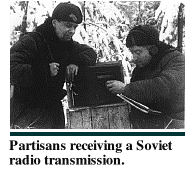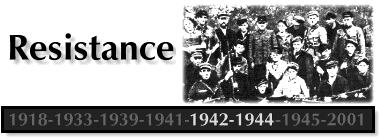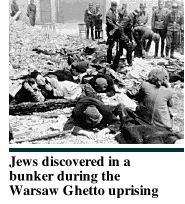
|
 Eastern Europe, especially Belorussia, the western Ukraine, and Lithuania, had wide expanses of forests and swamps which were ideal for guerrilla warfare. Joseph Stalin called for the establishment of an underground movement in the occupied territories to fight the enemy, and in June 1942, central headquarters were established for the entire partisan movement.
Eastern Europe, especially Belorussia, the western Ukraine, and Lithuania, had wide expanses of forests and swamps which were ideal for guerrilla warfare. Joseph Stalin called for the establishment of an underground movement in the occupied territories to fight the enemy, and in June 1942, central headquarters were established for the entire partisan movement.
With the influx of Jews into the partisan movement, family camps evolved, especially in Belorussia. These camps ranged from a few families to several hundreds of families. The families took refuge in forests primarily in an effort to save their lives, and secondarily to fight the enemy.
In western Europe, large scale guerrilla movement was impossible due to the more open topography. However, there were acts of organized armed resistance.
In total, partisans were relatively few in number, but because of their ability to move within enemy territory they could disrupt Nazi activity. Partisans interfered with enemy communication by cutting telephone, telegraph, and electrical lines and by destroying power stations. They sabotaged transportation links by blowing up bridges, roads, and railway equipment, and they sabotaged factories that produced materials for the Axis  war effort. war effort.
 Nine photographs of resistance groups in the forest, in the ghetto, and even in death camps. Nine photographs of resistance groups in the forest, in the ghetto, and even in death camps.
 Map of Jewish Partisan activity in Eastern Europe, 1942-43. Map of Jewish Partisan activity in Eastern Europe, 1942-43.
|


 April 19, 1943 marked the beginning of an armed revolt by a courageous and determined group of Warsaw ghetto
April 19, 1943 marked the beginning of an armed revolt by a courageous and determined group of Warsaw ghetto